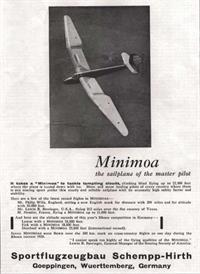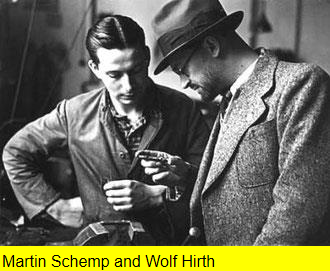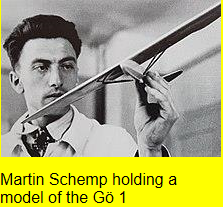
Martin Schempp was born in Stuttgart. After completing his commercial education, he helped out in his father's craftsman's business. In 1926, at the age of 21, he emigrated to the USA in the hope of finding better working conditions there. After working at various odd jobs, he finally found employment as a chemical laboratory technician at a steel mill. A talk by Charles Lindbergh about his Atlantic crossing so inspired Martin about aviation that he returned to Germany in 1928 to learn how to fly. After completing his basic soaring training, he acquired his pilot's license for powered aircraft at the Klemm company in Böblingen. It was during this time that he met Wolf Hirth, with whom he was to establish a close, lifelong friendship.
Martin Schempp returned 1929 to the USA to build German sailplane designs under license there at "Haller-Hirth Sailplanes" and to act as a soaring instructor at "Haller School Of Soaring Flight" in Pittsburgh (Greensburg Airport). Spectacular flights with a number of unintentional ditchings made him and soaring known in the USA. After his successes in the 2nd National Soaring Championships in Elmira, New York (which is America's equivalent to the Wasserkuppe, Germany's soaring Mecca) in 1931, he flew a distance of 63.7 miles and reached an altitude of 5,370 feet in this competition the following year. He won second place in the distance competition and first place in the altitude competition. Based on these successes, he earned silver C badge No. 8 (worldwide). He moved to California at the end of 1932, where he worked with Hawley Bowlus on his high-performance sailplane "Albatros".
In 1934, feeling that his professional prospects in the USA were too uncertain, Martin Schempp accepted an offer from Wolf Hirth, who was the head of the soaring school on the Hornberg at the time, to hire him as a soaring instructor there. With the assistance of Wolf Hirth, Martin Schempp opened in Göppingen his own company in 1935: "Sportflugzeugbau Göppingen Martin Schempp". Martin Schempp proved to be an adept and circumspect head of production, who would succeed over decades in working with his employees to build high-quality sailplanes inexpensively. The Gö 1 "Wolf" and Gö 3 "Minimoa" became world-renowned sailplanes. In 1938, Wolf Hirth, mainly responsible for the design work, officially became a partner in the company, which then took on the new name “Sportflugzeugbau Schempp-Hirth”. The company relocated to Kirchheim-Teck the same year. By 1939, the list of customers included clients from all continents except Australia. The Minimoa, 110 of which were built, is still regarded as one of the most beautiful sailplanes from the wood era. In 1939, Wolf Hirth opened his own company in Nabern, which collaborated closely with Schempp-Hirth during the war. In addition to sailplanes for pilot training, the two companies supplied the two-seater Gö IV (designed by Wolfgang Hütter); the Habicht (plane), an aerobatic glider, and wooden subassemblies for Messerschmitt, the Me-321/323 "Gigant" and the Me-109 fighter.




